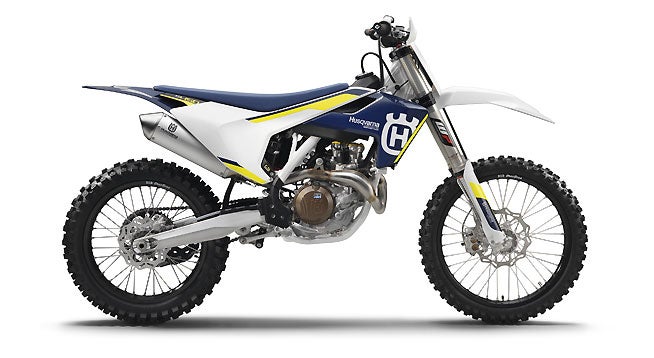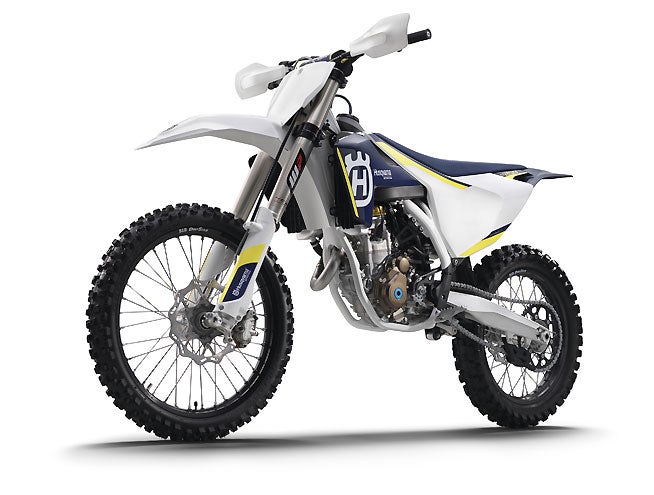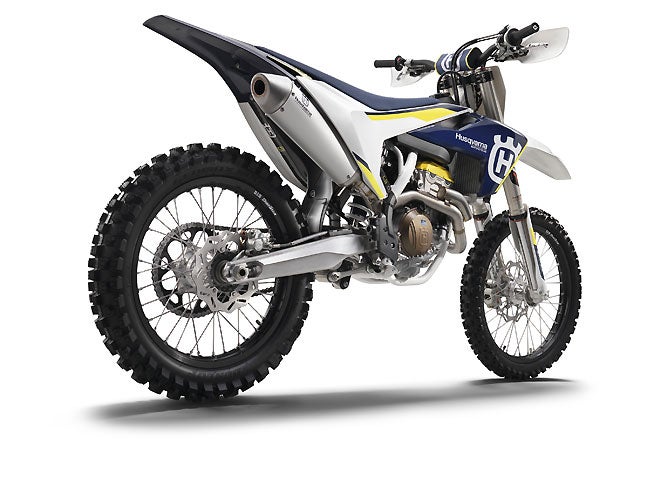2016 Husqvarna FC 450

Husqvarna’s 2016 FC450 is claimed to feature the most powerful Husqvarna motocross engine ever developed, with a whopping 63 crankshaft horsepower oozing from the SOHC 450cc Single, which is now smaller and lighter and has been completely redesigned for optimal mass-centralization within the new chassis. The engine is 23mm shorter, 23mm narrower and 9mm lower than the previous FC 450 engine. Husqvarna says that every internal component was revised and repositioned, reducing engine weight by lowering weight by 3.96 lbs.; total engine weight is a claimed 61.16 lbs. Like its FC 250 and FC 350 siblings, the FC 450 uses a multifunctional counterbalancer shaft that also drives the water pump and timing chain to help reduce internal engine parts and also reduce mass.
The FC 450’s SOHC cylinder head is completely new, with a totally different combustion chamber, and intake and exhaust ports, compared to the 2015. A camshaft with new profiles, bumps the Husqvarna’s titanium 40mm intake and 33mm exhaust valves. A low-friction DLC coating is used on the rocker arm, new shorter timing chain and low-friction chain guides all help the mighty Husqvarna engine to reach its 11,500 rpm redline.
The rest of the FC 450’s top end is changed as well, with a 95mm bore cylinder that is positioned 6mm lower and features a revised water jacket. A new CP bridge-box-type piston weighs 320 grams and helps to boost the engine’s compression ratio to 12.6:1. A new crankshaft design boasts 10% more inertia and has been repositioned 9mm backwards and 7mm higher in the FC 450’s all-new engine high-pressure die-cast engine cases.
Husqvarna engineers gave the FC 450 a lighter and more compact five-speed gearbox that is 8mm narrower and 350 grams lighter than the previous generation. A new surface treatment on first and fifth gears is said tp improves reliability and, combined with a new low-friction coating on the shifting fork and a redesigned shift drum, guarantee smooth and precise shifting. The gear lever also features a new tip design that prevents dirt build-up. An advanced gear sensor allows for specific engine maps in each gear.
A new DDS (damped diaphragm steel) clutch system with a lighter clutch basket has been fitted to the FC 450. The inner hub and pressure plate have also been redesigned to improve oil flow and cooling, while the Magura hydraulics and a Magura lever are also used. The DDS system uses a single diaphragm steel pressure plate instead of traditional coil springs along with an integrated damping system for better traction and durability. The clutch basket is a single-piece CNC machined steel component that allows the use of thin steel liners and contributes to the narrowness of the engine.
• Electric starter and compact Li-Ion battery
2016 Husqvarna FC 250

The FC 250 benefits from a completely new 250cc DOHC engine with a number of internal changes designed to match the new chassis and centralize mass. The FC 250’s crankshaft has been repositioned inside new crankcases to set 6mm higher than in the previous engine, but thanks to a 6mm shorter connecting rod and a repositioning of other internal components as well as the redesigned crankcases, the engine height has been reduced by 20mm, bringing the mass closer to the bike’s center of gravity. T
The FC 250 engine is not only smaller, it is also 2.4 lbs. lighter while maintaining a claimed power output of 46 crank horsepower, thanks to a new DOHC cylinder head with a revised combustion chamber, along with new camshafts with revised timing. To combat internal friction, a 30% harder DLC coating on the finger followers is used. The engine also gets new valve springs and retainers to help control its titanium 32.5mm intake and 26.5mm exhaust valves.
A new, forged, bridged-box –style piston made by aftermarket piston manufacturer CP rides in the FC 250’s 78mm bore. The new piston is 130 grams lighter than the old one, which reduces reciprocating weight for better engine response. The FC 250’s compression ratio is 14.4:1.
The crankshaft has been redesigned for increased rigidity. It features a plain big end bearing and two force-fitted bearing shells for maximum reliability and durability—Husqvarna quotes a service interval of 100 hours. New, more compact crankcases not only raise the crank centerline, they also reposition the clutch shaft is 11.1 mm further back and 26.9 mm higher. These modifications required a complete redesign of the crankcases which are now significantly more compact and lighter. Husqvarna says that the high-pressure die cast production process used for the cases helps to reduce the engine’s overall weight, thanks to the thinner wall thickness of the cases.
Husqvarna engineers also designed the FC 250’s gearbox to make it lighter and more durable. The gear ratios are the same as the 2015 FC 250’s, but the cogs are wider, and the second- third- and fourth-gear cogs are surface-treated. The shifting fork also gets a new low-friction coating for slicker shifting, while the gear lever itself is designed to prevent dirt buildup. An advanced gear sensor allows for specific engine maps in each gear.
Both the FC 250 and FC 350 feature CSS (coil spring steel) clutches with Magura hydraulics and lever. The CSS clutch has six coil springs and seven clutch plates in place of the previous eight plates, and a new, lighter one-piece, CNC-machined steel clutch basket. The inner hub and pressure plate have been redesigned to improve oil flow and separation, while the new coil springs give a more consistent feel.
2016 Husqvarna FC 350

The 2016 FC 350 shares much of its engine architecture with the smaller FC 250, with its compact size and light weight, while producing power that is closer to the FC 450’s. All the FC 250’s DOHC engine benefits are matched to a new engine management system with a new standard launch control, switchable engine maps and a faster processor to help harness the FC 350’s 58 crank horsepower. The repositioning of the crankshaft and clutch shaft, together with the complete redesign of all the internal components as well as the crankcases, results in a 20mm shorter engine that is 2.2 lbs. lighter than the previous generation engine and is mounted closer to the bike’s center of gravity.
Same as the FC 250, the FC 350 gets a new DOHC cylinder head with a redesigned combustion chamber, new ports, new camshafts and new valve springs. The DLC coating on the finger followers is 30% harder, therefore reducing friction. Large, titanium 36.3 mm diameter intake and 29.1 mm exhaust valves help the engine to rev freely to the 13,400 rpm. The Fc 350’s bore is 10mm larger than the FC 250’s, measuring 88mm with a 57.5mm stroke. A lightweight, forged, bridged-box-type piston by CP contributes to recued reciprocating mass. A new stiffer crankshaft features a plain big-end bearing and two force-fitted bearing shells for maximum reliability and durability, with a service interval of 100 hours.
Like its siblings, the FC 350’s new engine cases were designed with mass-centralization and weight reduction as the main goals. All the major components have been repositioned; the crankshaft has been raised by 6mm while the clutch shaft is 11.1mm further back and 26.9mm higher. The new cases use a high-pressure die cast production process to help keep their overall weight to a minimum by creating a thin wall thickness.
A new surface treatment on second, third and fourth gears combined with a new low-friction coating on the shifting fork was applied to help increase shifting precision. The gear ratios are unchanged, but the gear lever features a new tip design that prevents dirt buildup. An advanced gear sensor allows for specific engine maps in each gear.
The 250cc and 350cc engines feature CSS (coil spring steel) clutches with Magura hydraulics and a Magura lever. The CSS clutch uses six coil springs and seven clutch plates instead of eight plates, along with a new, lighter one-piece CNC machined steel clutch basket. The inner hub and pressure plate have been redesigned to improve oil flow and separation, while the new coil springs are claimed to give a more consistent feel.
For more information on the 2016 line of Husqvarna motocross models, visit Husqvarna-Motorcycles.com
 Your Privacy Choices
Your Privacy Choices